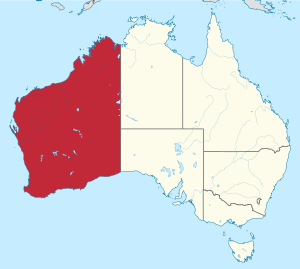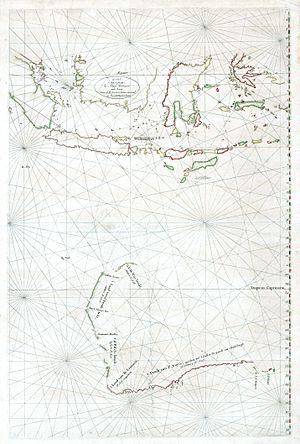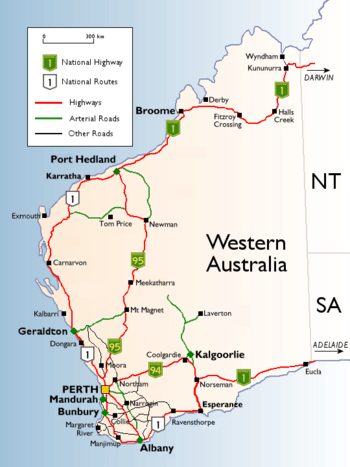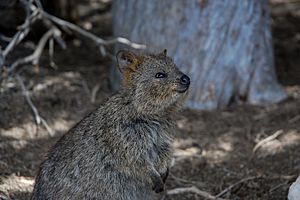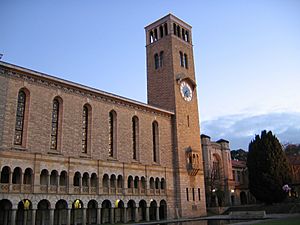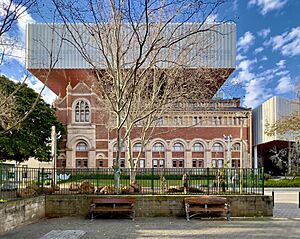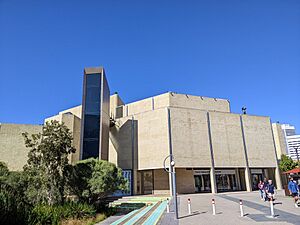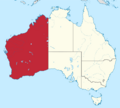Western Australia facts for kids
Quick facts for kids
Western Australia
|
|||
|---|---|---|---|
|
|||
Nickname(s):
|
|||
|
Location of Western Australia in Australia
26°S 121°E / 26°S 121°E |
|||
| Country | Australia | ||
| Before federation | Colony of Western Australia | ||
| Established as the Swan River Colony | 2 May 1829 | ||
| Responsible government | 21 October 1890 | ||
| Federation | 1 January 1901 | ||
| Capital
and largest city
|
Perth | ||
| Administration | 139 local government areas | ||
| Demonym(s) |
|
||
| Government | |||
|
• Monarch
|
Charles III | ||
|
• Governor
|
Chris Dawson | ||
|
• Premier
|
Roger Cook (Labor) | ||
| Legislature | Parliament of Western Australia | ||
| Legislative Council | |||
| Legislative Assembly | |||
| Parliament of Australia | |||
|
• Senate
|
12 senators (of 76) | ||
| 15 seats (of 151) | |||
| Area | |||
|
• Total
|
2,527,013 km2 (975,685 sq mi) (1st) | ||
| Highest elevation
(Mount Meharry)
|
1,249 m (4,098 ft) | ||
| Population | |||
|
• June 2023 estimate
|
2,878,600 (4th) | ||
|
• Density
|
1.11/km2 (2.9/sq mi) (7th) | ||
| GDP (nominal) | 2022 estimate | ||
|
• Total
|
AU$377.257 billion (4th) | ||
|
• Per capita
|
AU$135,320 (1st) | ||
| HDI (2021) | very high · 2nd |
||
| Time zone |
|
||
| Postal abbreviation |
WA
|
||
| ISO 3166 code | AU–WA | ||
| Symbols | |||
| Mammal | Numbat (Myrmecobius fasciatus) |
||
| Bird | Black swan (Cygnus atratus) |
||
| Fish | Whale shark (Rhincodon typus) |
||
| Flower | Red and green kangaroo paw (Anigozanthos manglesii) |
||
| Fossil | Gogo fish (Mcnamaraspis kaprios) |
||
| Colour | Black and gold | ||
Western Australia (WA) is a huge state of Australia. It covers the western third of the entire Australian continent. It's bordered by the Indian Ocean to the north and west, and the Southern Ocean to the south. To the east, it meets the Northern Territory and South Australia.
Western Australia is Australia's largest state. It's also the second-largest area of any country on Earth, after the Sakha Republic in Russia. The state has a total land area of over 2.5 million square kilometres.
This state has many different climates. You can find tropical weather in the Kimberley region. There are also large deserts in the middle, like the Great Sandy Desert and Great Victoria Desert. The south-west and southern coast have a Mediterranean climate, which means warm, dry summers and mild, wet winters.
As of 2021, about 2.91 million people live in Western Australia. Most of them (over 90%) live in the south-west part of the state. About 80% of the state's population lives in the capital city, Perth. This means the rest of the state is very sparsely populated, with few people living there.
The Trans-Australian Railway and the Eyre Highway cross the Nullarbor Plain in the south-east. These are the main ways to travel between Western Australia and the more populated eastern states.
Western Australia has a rich history with its Indigenous peoples, who have lived there for tens of thousands of years. European explorers, mainly from the Netherlands, started visiting in the 1600s. Dirk Hartog was the first European to land there in 1616. The British officially claimed Western Australia in 1827. They set up the Swan River Colony in 1829, with Perth as its capital.
The discovery of gold in the late 1800s brought many new people to Western Australia. The colony gained the right to govern itself in 1890. Then, in 1901, it joined with the other Australian colonies to form the country of Australia.
Western Australia's economy relies a lot on its mining industry. It's a world leader in mining iron ore. It also has large offshore oil and natural gas reserves. Gold mining is still very important. Many other minerals are also mined here. Besides mining, farming and fishing are also big parts of the state's economy.
Contents
Western Australia's Past: A Journey Through Time
Ancient Beginnings and First Peoples
Western Australia has a very old geological history. Some rocks here formed 4.4 billion years ago! The earliest known life on land, called stromatolites, started forming about 3.48 billion years ago. These are like tiny layered rocks made by microbes.
The first humans arrived in Australia from the north a very long time ago, possibly as far back as 70,000 years ago. These Indigenous Australians lived all across Western Australia long before Europeans arrived.
European Explorers Arrive
The first Europeans to visit Western Australia were from a Dutch expedition led by Dirk Hartog. They landed on 25 October 1616, at what is now Dirk Hartog Island. For the rest of the 1600s, other Dutch and British sailors explored the coast. They often landed by accident due to storms or poor navigation.
By the late 1700s, British and French sailors began exploring the Western Australian coast more carefully. A French expedition in 1800-1803 created the first map showing the full outline of Australia.
Founding the Colony
The British started a settlement at King George III Sound in 1827. This was because they were worried France might try to set up a colony there. This settlement later became Albany.
In 1829, the Swan River Colony was founded on the Swan River by Captain James Stirling. By 1832, about 1,500 British settlers lived there. The colony's official name was changed to Western Australia. The two main towns that grew from this colony were the port city of Fremantle and the capital, Perth.
Gold Rush and Self-Government
For many years, the population grew very slowly. But in the 1890s, huge amounts of gold were found around Kalgoorlie. This led to a big increase in people moving to Western Australia.
In 1887, a new plan for governing the colony was made. This plan gave European Australians the right to govern themselves. In 1890, the British Parliament approved this, and Western Australia became a self-governing colony. John Forrest became the first Premier (leader) of the state.
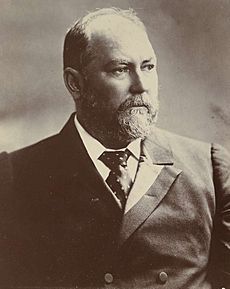
After gold was found at Coolgardie and Kalgoorlie, the Western Australian Parliament approved a plan to build a pipeline. This pipeline would bring 23 million litres of water per day to the goldfields. The pipeline, called the Goldfields Water Supply Scheme, was finished in 1903. It carries water 530 km (330 mi) from Perth to Kalgoorlie. Historians say this pipeline was very important for the state's population and economic growth.
Joining Australia
Thanks to a campaign led by John Forrest, the people of Western Australia voted to join the other Australian colonies. On 1 January 1901, Western Australia officially became a state of Australia.
Western Australia's Geography and Climate
Where is Western Australia?
Western Australia is bordered on the east by a line of longitude (129°E). This line forms the border with South Australia and the Northern Territory. To the west and north, it's bordered by the Indian Ocean. The water south of the continent is officially called the Southern Ocean in Australia.
The state's eastern border is 1,862 km (1,157 mi) long. It has a very long coastline of 20,781 km (12,913 mi), including many islands. The total land area is about 2.5 million square kilometres (970,000 sq mi).
Land and Landscapes
Most of Western Australia is made up of very old landforms called cratons. These are parts of the Earth's crust that have been stable for billions of years. Because there hasn't been much mountain-building here, the land is very old and worn down.
Most of the state is a low plateau, about 400 metres (1,200 ft) high. The highest point is Mount Meharry in the Hamersley Range, which is 1,249 metres (4,098 ft) high. The land slopes down to coastal plains, sometimes forming steep cliffs like the Darling Scarp near Perth.
The soils in Western Australia are often not very fertile. This is because the landscape is so old. Farmers often need to use a lot of fertilisers. Large areas of land have been cleared for farming, which has affected native plants and animals. The south-west region is a "biodiversity hotspot," meaning it has many unique species.
Weather Across the State
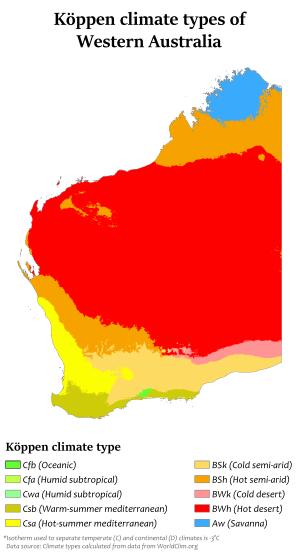
The south-west coastal area has a Mediterranean climate. This means warm, dry summers and mild, wet winters. This area used to have thick forests, including tall karri trees. It's also rich in marine life, with some of the world's most southerly coral reefs.
Rainfall in the south-west ranges from 300 mm (12 in) to 1,400 mm (55 in) per year. But from November to March, it's very dry. Plants here are specially adapted to these dry conditions and poor soils.
The middle two-thirds of the state are very dry and have few people. The main activity here is mining. Annual rainfall is usually less than 300 mm (8–10 in). Most of this rain comes in heavy downpours during summer cyclones.
The northern tropical regions, like the Kimberley, have a hot monsoonal climate. They get a lot of rain, from 500 to 1,500 mm (20–60 in) per year. However, there's a very long dry season from April to November. Most of the state's water runoff happens in the Kimberley.
Snow is rare in Western Australia. It usually only falls in the Stirling Range near Albany, which is far enough south and high enough. Very rarely, snow can fall in other hilly areas of the south-west.
The highest temperature ever recorded in WA was 50.7 °C (123.3 °F) in Onslow on 13 January 2022. The lowest was −7.2 °C (19.0 °F) at Eyre Bird Observatory on 17 August 2008.
Amazing Animals and Plants
Western Australia is home to about 630 different kinds of birds. Around 15 of these birds are found only in Western Australia. The best places to see birds are the south-western corner and the area around Broome and the Kimberley.
The state also has over 10,000 types of native plants. The south-west region has one of the highest numbers of plant species for its size in the world. Many of these plants are found nowhere else.
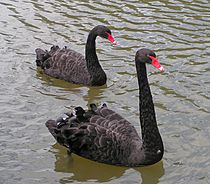
Western Australia has many different natural areas, called ecoregions. These include the sandstone gorges of the Kimberley in the north, and dry shrublands like the Pilbara and Carnarvon regions. Along the southern coast, you'll find forests and shrublands, especially around the Margaret River wine area. The middle of the state is covered by large deserts.
In 1831, a Scottish botanist named Robert Brown wrote about the plants of the Swan River Colony.
Western Australia's People

Europeans started settling permanently in Western Australia in 1826. This was when Albany was claimed by Britain. Perth was founded in 1829 by British and Irish settlers. At first, the colony grew slowly. Its leaders even asked for help from convicts to increase the population.
In the 1890s, the gold rush brought many people from other Australian states. This caused a big jump in the population.
After World War II, many immigrants came to Western Australia from Italy, Croatia, and Macedonia. However, Britain has sent the most immigrants to Western Australia over time. Perth, especially, has a high number of British-born residents.
Perth's metropolitan area, including Mandurah, had an estimated population of over 2 million people in June 2017. This is about 79% of the state's total population. Other important towns include Bunbury, Geraldton, Kalgoorlie-Boulder, and Albany.
Ancestry and Languages
At the 2016 census, the most common backgrounds people identified with were English, Australian, Irish, and Scottish. About 3.1% of the population, or 75,978 people, identified as Indigenous Australians (Aboriginal Australians and Torres Strait Islanders) in 2016.
In 2016, 75.2% of people in Western Australia spoke only English at home. Other common languages included Mandarin, Italian, Vietnamese, and Cantonese.
Religions
According to the 2021 census, Christianity is the main religion in Western Australia, followed by 41.1% of the people. The number of people who say they have no religion has grown from 8.7% in 1971 to 42.9% in 2021. Smaller groups of people follow Muslim, Buddhist, and Hindu faiths.
Western Australia's Economy
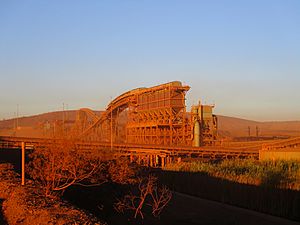
Western Australia's economy is mostly based on digging up and processing minerals and oil. The state's natural resources give it a big advantage in these industries.
- Western Australia produces about 58% of Australia's mineral and energy exports.
- The money earned per person in Western Australia is higher than in any other Australian state.
- The state has started producing a wider range of goods in the last 15 years. This helps protect the economy from big changes in world prices.
- Growing global demand for minerals and oil, especially from China and Japan, has helped Western Australia's economy grow faster than the national average.
In 2019, Western Australia's exports to other countries made up 46% of Australia's total exports. The main things exported were iron ore, oil, gold, alumina, nickel, and wheat.
Western Australia is the world's biggest producer of iron ore. It also mines a lot of gold. It's a major producer of bauxite, which is turned into alumina. Until 2020, the world's largest diamond mine was in the Kimberley region. Coal mined at Collie is used to make most of the electricity in the state's south-west.
Farming is also a big part of the economy. Western Australia produces about half of Australia's wheat. Other important farm products include wool, beef, lamb, and barley. There's a high demand for live animals from WA, especially from Southeast Asian and Middle Eastern countries.
The growth in mining has led to a shortage of workers. The state government has been trying to encourage people from other states and countries to move to Western Australia.
South of Perth, the Kwinana area has many heavy industries. It used to have Australia's largest oil refinery, which closed in 2021. Kwinana also has plants that process alumina and nickel. It's a major port for exporting grain and other goods.
Western Australia has a big fishing industry. They catch rock lobsters, prawns, crabs, shark, and tuna. There's also pearl fishing in the Kimberley region.
The state has the world's biggest farms for Indian sandalwood and Australian sandalwood. These trees are used to make sandalwood oil and incense. Western Australia's sandalwood industry provides about 40% of the world's sandalwood oil.
Tourism in Western Australia

Tourism has become very important in recent years. Many visitors come from the UK, Ireland, Singapore, Japan, and Malaysia. Money from tourism helps many smaller towns outside of Perth, especially those on the coast.
Tourism brings in $9.3 billion to Western Australia's economy and supports 94,000 jobs. It makes up 3.2% of the state's economy. Tourism WA is the government agency that promotes Western Australia as a holiday spot.
Education in Western Australia
In Western Australia, children start with one year of pre-school at age 4 or 5. Then they have six years of primary school. After that, they go to secondary school for six years, starting at age 12 or 13. Students must stay in school until they are 16. Sixteen and 17-year-olds need to be in school, training, or working.
After Year 10, students can choose to go to a TAFE college for vocational training. Or they can continue to Year 12 to prepare for university.
Western Australia has five universities. Four of them are public universities in Perth: the University of Western Australia, Curtin University, Edith Cowan University, and Murdoch University. There is also one private Catholic university in Fremantle, the University of Notre Dame Australia.
Media and News
Print Media

Western Australia has two daily newspapers: The West Australian and the Kalgoorlie Miner. There is also a weekend paper, The Weekend West, and a Sunday paper, The Sunday Times.
Many weekly community newspapers are distributed from Yanchep in the north to Mandurah in the south. There are also two major weekly rural papers: Countryman and Farm Weekly. WAtoday is an online newspaper that focuses on news from Perth and Western Australia.
Television
Perth has five main television stations:
- ABC TV WA (Channel 12 Digital)
- SBS WA (Channel 7 Digital)
- Seven Network Perth (Channel 6 Digital)
- Nine Network Perth (Channel 8 Digital)
- Network Ten Perth (Channel 11 Digital)
Regional Western Australia has similar TV stations. It's one of the largest television markets in the world by area.
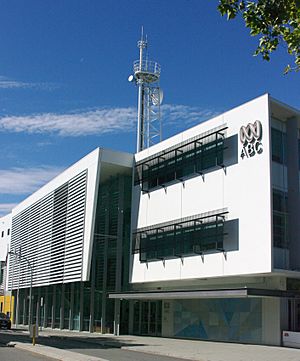
In addition to the main channels, broadcasters also offer digital multi-channels. These include ABC HD, ABC TV Plus, ABC Me, ABC News, SBS HD, SBS Viceland, SBS World Movies, SBS Food, NITV, SBS WorldWatch, 7HD, 7TWO, 7mate, 7flix, Racing.com, 9HD, 9Gem, 9Go!, 9Life, 9Rush, Extra, 10 Bold, 10 Peach, 10 Shake, 10 HD, TVSN, and Gecko TV.
Pay TV services are available through Foxtel, mostly via satellite.
Radio
Perth has many radio stations on both AM and FM. ABC stations include ABC NewsRadio, ABC Radio Perth, Radio National, ABC Classic FM, and Triple J. The main commercial stations are Triple M, Nova 93.7, Mix 94.5, 96FM, AM 882, AM 1080, and AM 1116.
Popular community radio stations include Curtin FM 100.1, RTRFM 92.1, Sonshine FM 98.5, and 91.3 SportFM.
Western Australia's Culture
Arts and Entertainment
Western Australia is home to the famous Western Australian Academy of Performing Arts (WAAPA), which trains performers. The state also has a growing theatre and music scene. Many well-known musicians and bands are from or have lived in Western Australia. These include Adam Brand, Birds of Tokyo, Bon Scott, Eskimo Joe, John Butler Trio, Tame Impala, and Troye Sivan. The West Australian Music Industry Awards (WAMis) celebrate the best musicians in WA every year.
Famous actors and TV personalities from Western Australia include Heath Ledger, Sam Worthington, Ernie Dingo, Isla Fisher, and Rove McManus. Many films and TV shows have been filmed in Western Australia, such as Rabbit-Proof Fence, Mystery Road, Red Dog, and Australia.
The West Australian Symphony Orchestra (WASO) performs at the Perth Concert Hall. Other places for concerts and performances include His Majesty's Theatre and Perth Arena. Performing arts groups in Perth include the West Australian Ballet and the West Australian Opera.
Many famous Australian books are set in Western Australia or written by authors from here. These include works by Tim Winton, Kim Scott, and Craig Silvey.
The public Art Gallery of Western Australia is in the Perth Cultural Centre. It has a collection of art from local and international artists. The Perth Cultural Centre also has the Western Australian Museum, the State Library of Western Australia, and the Perth Institute of Contemporary Arts (PICA). Western Australia has a public library system with libraries in every local government area.
Sports in Western Australia

Western Australia is home to many national and international sports teams and events:
- Australian Rules Football: The West Coast Eagles and the Fremantle Dockers play in the Australian Football League (AFL). They also have women's teams in the AFL Women's league.
- Baseball: The Perth Heat play in the Australian Baseball League.
- Basketball: The Perth Wildcats (men) and Perth Lynx (women) play in Australia's top basketball leagues.
- Cricket: The Western Australia cricket team represents the state in first-class cricket. The Perth Scorchers play in the Twenty20 Big Bash League.
- Field Hockey: The WA Thundersticks (men) and Diamonds (women) play in the Australian Hockey League.
- Netball: The West Coast Fever play in the ANZ Championship.
- Rugby Union: The Western Force plays in Super Rugby Pacific.
- Soccer: Perth Glory has both men's and women's teams in Australia's A-League.
Western Australia has also hosted major international sporting events, like the 2002 Women's Hockey World Cup and the 1962 British Empire and Commonwealth Games.
The largest sports stadium in Western Australia is Perth Stadium, also known as Optus Stadium. It can hold over 60,000 people and is mainly used for Australian rules football and cricket.
Wine Regions
Western Australia's winemaking regions are found in the cooler south-western part of the state. While Western Australia produces less than 5% of Australia's wine, it is known for its high quality. Major wine regions include Margaret River, The Great Southern, and Swan Valley.
Sister States
Western Australia has five sister states around the world. These partnerships help improve cultural and economic ties.
- East Java, Indonesia
- Hyōgo Prefecture, Japan
- Andhra Pradesh State, India
- Tuscany Region, Italy
- Zhejiang Province, China
In 1981, Western Australia and Hyōgo Prefecture in Japan signed a sister state agreement. This was to improve cultural connections. To celebrate 10 years of this agreement, the Hyōgo Prefectural Government Cultural Centre was opened in Perth in 1992.
After a big earthquake hit Hyōgo in 1995, groups and businesses from Western Australia sent money and supplies to help. People also travelled there to help with relief and rebuilding. In 2001, both governments signed an agreement to improve their economic relationship.
The City of Rockingham in Western Australia and the City of Akō in Hyōgo also have a sister city agreement, signed in 1997. This is one of nine sister city relationships between Western Australian and Japanese cities.
Images for kids
See also
 In Spanish: Australia Occidental para niños
In Spanish: Australia Occidental para niños




